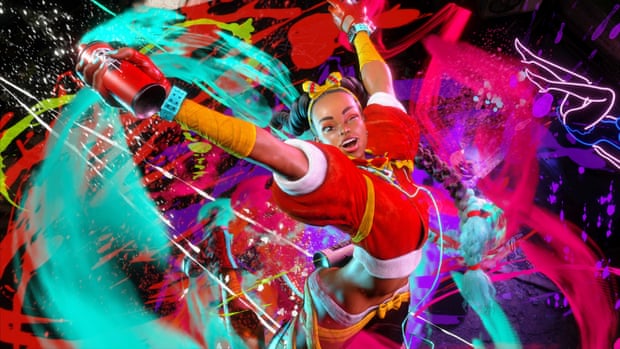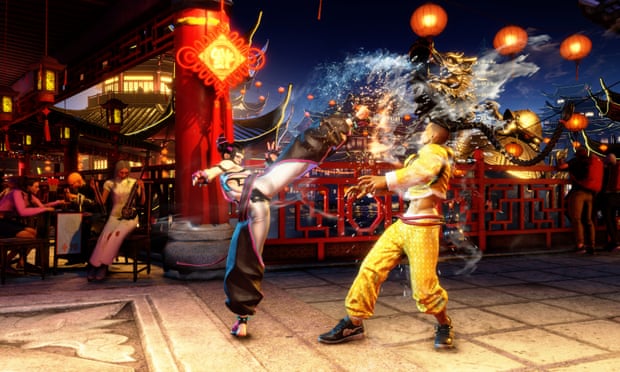If there’s one name synonymous with fighting games, it’s Street Fighter. Dominating arcades in the late 80s and 90s and spawning the living room-conquering Super Nintendo classic Street Fighter II, Capcom’s beat ’em up became a cultural phenomenon. But since the death of the arcade, fighting games have become more niche. While 2016’s Street Fighter V slowly became a competitive esports sensation, it lacked the earlier games’ universal appeal. Now, 31 years after Street Fighter II, Capcom is reinventing its prize fighter for a new generation. Visually, Street Fighter 6 is forging a new identity for the franchise, sporting an eye-catching aesthetic that combines unattainably bulging biceps with attacks that explode in a burst of colour.
“I really want to make Street Fighter a game that everyone can play, like it used to be,” producer and series veteran Shuhei Matsumoto tells the Guardian. Offering a radical overhaul to its controls, Street Fighter 6 is a more accessible twist on spin-kicking, fireball-throwing fighting spectacle. A newbie-friendly control option ditches the classic six-button setup of high and low punches and kicks in favour of a simpler three-button structure, allowing first-timers to pull off a Shoryuken without spending months developing the muscle memory.
Wisely, however, this new control method is entirely optional: veterans can still get their KOs the old way. “That’s our concept for Street Fighter 6: we need to not only meet the needs of hardcore fighting game fans, casual fighting players and those who love the world and characters of Street Fighter, but also players who are thinking of starting out with this new game,” says Matsumoto.
The fiction and characters of Street Fighter – mostly explored in manga and anime spin-offs, so far, rather than in the games themselves – actually take centre stage in an intriguing new story-led adventure mode, inspired by the Dreamcast classic Shenmue. “The game is expanding beyond battles to include a World Tour mode, where you can explore the world of the game,” says Takayuki Nakayama, director of Street Fighter 6. Instead of fighting a lineup of opponents in a tournament, World Tour has players guiding a custom fighter through, for instance, the graffiti-coated streets of Metro City.
“I felt like most of the Street Fighter games in the past have only been able to offer a versus mode and a training mode,” Nakayama adds. “So, I wanted to approach SF6 as if the versus mode were endgame content, and before you got into that, you would have an introduction into the world of Street Fighter … a way to get to grips with the game.”
This contrasts favourably with the barebones offline experience offered by Street Fighter V, which launched without even a single-player arcade mode. It wasn’t until years later that V packed enough content to justify its hefty £49.99 price tag. “I know that we need to make sure the volume of content in the game is satisfying,” replies Nakayama, when asked what lessons have been learned.
“One of the lessons of SFV was that communication with the fanbase is key,” Matsumoto adds. “For SF6 we definitely want to make sure that players get a very clear message from the director and the dev team on what it is we are making, and what we want to achieve.”
As one of the first ever properly competitive video games, Street Fighter should be one of the world’s most watched esports, too. Thanks to massive health bars, mesmerising attacks and their simple 1v1 format, fighting games are contests that casual onlookers can immediately understand. But despite this, viewing figures for beat ‘em ups lag far behind shooters like Call of Duty and Fortnite. Is this something that Street Fighter 6’s creators want to chase?

“I think that the directness and readability of fighting games make them a great fit for esports. But I don’t think that the fighting genre necessarily needs to be the most watched in the world in order to have meaningful impact,” says Matsumoto. “I’m happy that we have a great fanbase and fighting game community who have been playing the games for years, and will continue to do so as long as we release them. I’m grateful for the support of the FGC [fighting game community] … that’s all I need!”
Street Fighter 6 is still a year away from release, so much of Capcom’s colourful scrimmage remains a mystery – leaving the internet to spawn its own amusing theories. Thanks to snippets of dialogue from the trailers – and a particularly haggard-looking redesign of iconic character, Ken – fans have concluded that his old rival Ryu has stolen his wife. While the developers sadly declined to comment on the “Hot Ryu v Divorcee Ken” meme, patter like this is building a buzz in the gaming world.
“I really think that we are making a new kind of Street Fighter in SF6,” says Matsumoto. For the first time in decades, Street Fighter feels unpredictable again.

